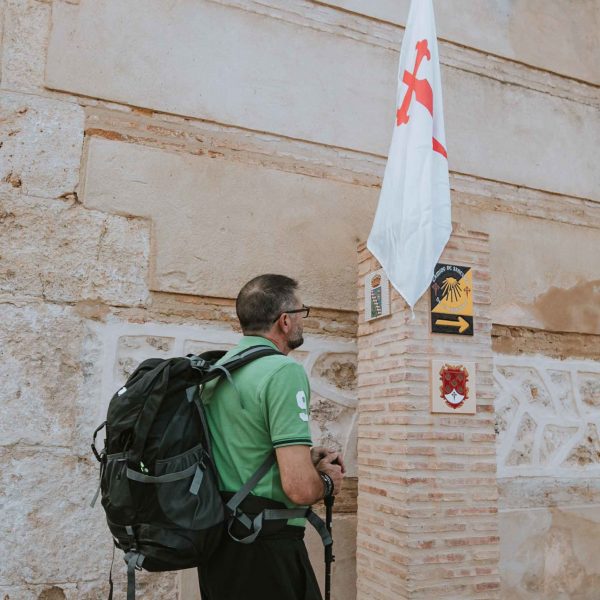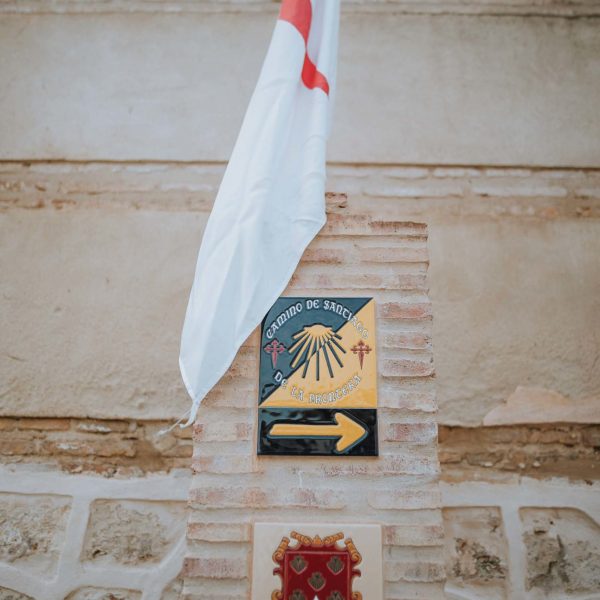
The Camino de la Frontera (Frontier’s Road) inherits this name for historical reasons, as it marked the political and physical limits of the two Andalusias that existed during the late Middle Ages, becoming a pilgrimage route.
The towns and villages of Seville that make up the Camino de Santiago to Santiago de Compostela are linked to the Camino de la Frontera by their belonging to the old Moorish Band and by the close relationship of many of them to Santiago de Compostela, as evidenced by the union with the Leonese Priory of Santiago in the Jacobean commendation of Estepa, where the Camino de la Frontera also became the Camino de Santiago. According to chronicles and legends, the apostle Santiago (St. James the Greater) was preaching in Osuna and its surrounding lands prior to the year 43.
This path has a historically traced and documented route and is the least known of the three Andalusian paths, the Vía de la Plata which starts in Seville and the Mozarabic Way which originates in Almería.


| Cookie | Tipo | Duración | Descripción |
|---|---|---|---|
| cookielawinfo-casilla-funcional | 0 | 11 meses | La cookie está configurada por GDPR Cookie Consent para registrar el consentimiento del usuario para las cookies en la categoría "Funcional". |
| cookielawinfo-casilla-necesario | 0 | 11 meses | Esta cookie está configurada por el complemento GDPR Cookie Consent. Las cookies se utilizan para almacenar el consentimiento del usuario para las cookies en la categoría "Necesario". |
| cookielawinfo-casilla-otros | 0 | 11 meses | Esta cookie está configurada por el complemento de consentimiento de cookies de GDPR. La cookie se utiliza para almacenar el consentimiento del usuario para las cookies en la categoría "Otros. |
| cookielawinfo-casilla-rendimiento | 0 | 11 meses | Esta cookie está configurada por el complemento de consentimiento de cookies de GDPR. La cookie se utiliza para almacenar el consentimiento del usuario para las cookies en la categoría "Rendimiento". |
| cookielawinfo-checkbox-análisis | 0 | 11 meses | Esta cookie está configurada por el complemento de consentimiento de cookies de GDPR. La cookie se utiliza para almacenar el consentimiento del usuario para las cookies en la categoría "Análisis". |
| vista_política_cookies | 0 | 11 meses | La cookie está configurada por el complemento GDPR Cookie Consent y se utiliza para almacenar si el usuario ha dado su consentimiento o no para el uso de cookies. No almacena ningún dato personal. |
| Cookie | Tipo | Duración | Descripción |
|---|---|---|---|
| cookielawinfo-casilla-funcional | 0 | 11 meses | La cookie está configurada por GDPR Cookie Consent para registrar el consentimiento del usuario para las cookies en la categoría "Funcional". |
| cookielawinfo-casilla-necesario | 0 | 11 meses | Esta cookie está configurada por el complemento GDPR Cookie Consent. Las cookies se utilizan para almacenar el consentimiento del usuario para las cookies en la categoría "Necesario". |
| cookielawinfo-casilla-otros | 0 | 11 meses | Esta cookie está configurada por el complemento de consentimiento de cookies de GDPR. La cookie se utiliza para almacenar el consentimiento del usuario para las cookies en la categoría "Otros. |
| cookielawinfo-casilla-rendimiento | 0 | 11 meses | Esta cookie está configurada por el complemento de consentimiento de cookies de GDPR. La cookie se utiliza para almacenar el consentimiento del usuario para las cookies en la categoría "Rendimiento". |
| cookielawinfo-checkbox-análisis | 0 | 11 meses | Esta cookie está configurada por el complemento de consentimiento de cookies de GDPR. La cookie se utiliza para almacenar el consentimiento del usuario para las cookies en la categoría "Análisis". |
| vista_política_cookies | 0 | 11 meses | La cookie está configurada por el complemento GDPR Cookie Consent y se utiliza para almacenar si el usuario ha dado su consentimiento o no para el uso de cookies. No almacena ningún dato personal. |
| Cookie | Tipo | Duración | Descripción |
|---|---|---|---|
| cookielawinfo-casilla-funcional | 0 | 11 meses | La cookie está configurada por GDPR Cookie Consent para registrar el consentimiento del usuario para las cookies en la categoría "Funcional". |
| cookielawinfo-casilla-necesario | 0 | 11 meses | Esta cookie está configurada por el complemento GDPR Cookie Consent. Las cookies se utilizan para almacenar el consentimiento del usuario para las cookies en la categoría "Necesario". |
| cookielawinfo-casilla-otros | 0 | 11 meses | Esta cookie está configurada por el complemento de consentimiento de cookies de GDPR. La cookie se utiliza para almacenar el consentimiento del usuario para las cookies en la categoría "Otros. |
| cookielawinfo-casilla-rendimiento | 0 | 11 meses | Esta cookie está configurada por el complemento de consentimiento de cookies de GDPR. La cookie se utiliza para almacenar el consentimiento del usuario para las cookies en la categoría "Rendimiento". |
| cookielawinfo-checkbox-análisis | 0 | 11 meses | Esta cookie está configurada por el complemento de consentimiento de cookies de GDPR. La cookie se utiliza para almacenar el consentimiento del usuario para las cookies en la categoría "Análisis". |
| vista_política_cookies | 0 | 11 meses | La cookie está configurada por el complemento GDPR Cookie Consent y se utiliza para almacenar si el usuario ha dado su consentimiento o no para el uso de cookies. No almacena ningún dato personal. |
| Cookie | Tipo | Duración | Descripción |
|---|---|---|---|
| cookielawinfo-casilla-funcional | 0 | 11 meses | La cookie está configurada por GDPR Cookie Consent para registrar el consentimiento del usuario para las cookies en la categoría "Funcional". |
| cookielawinfo-casilla-necesario | 0 | 11 meses | Esta cookie está configurada por el complemento GDPR Cookie Consent. Las cookies se utilizan para almacenar el consentimiento del usuario para las cookies en la categoría "Necesario". |
| cookielawinfo-casilla-otros | 0 | 11 meses | Esta cookie está configurada por el complemento de consentimiento de cookies de GDPR. La cookie se utiliza para almacenar el consentimiento del usuario para las cookies en la categoría "Otros. |
| cookielawinfo-casilla-rendimiento | 0 | 11 meses | Esta cookie está configurada por el complemento de consentimiento de cookies de GDPR. La cookie se utiliza para almacenar el consentimiento del usuario para las cookies en la categoría "Rendimiento". |
| cookielawinfo-checkbox-análisis | 0 | 11 meses | Esta cookie está configurada por el complemento de consentimiento de cookies de GDPR. La cookie se utiliza para almacenar el consentimiento del usuario para las cookies en la categoría "Análisis". |
| vista_política_cookies | 0 | 11 meses | La cookie está configurada por el complemento GDPR Cookie Consent y se utiliza para almacenar si el usuario ha dado su consentimiento o no para el uso de cookies. No almacena ningún dato personal. |
| Cookie | Tipo | Duración | Descripción |
|---|---|---|---|
| cookielawinfo-casilla-funcional | 0 | 11 meses | La cookie está configurada por GDPR Cookie Consent para registrar el consentimiento del usuario para las cookies en la categoría "Funcional". |
| cookielawinfo-casilla-necesario | 0 | 11 meses | Esta cookie está configurada por el complemento GDPR Cookie Consent. Las cookies se utilizan para almacenar el consentimiento del usuario para las cookies en la categoría "Necesario". |
| cookielawinfo-casilla-otros | 0 | 11 meses | Esta cookie está configurada por el complemento de consentimiento de cookies de GDPR. La cookie se utiliza para almacenar el consentimiento del usuario para las cookies en la categoría "Otros. |
| cookielawinfo-casilla-rendimiento | 0 | 11 meses | Esta cookie está configurada por el complemento de consentimiento de cookies de GDPR. La cookie se utiliza para almacenar el consentimiento del usuario para las cookies en la categoría "Rendimiento". |
| cookielawinfo-checkbox-análisis | 0 | 11 meses | Esta cookie está configurada por el complemento de consentimiento de cookies de GDPR. La cookie se utiliza para almacenar el consentimiento del usuario para las cookies en la categoría "Análisis". |
| vista_política_cookies | 0 | 11 meses | La cookie está configurada por el complemento GDPR Cookie Consent y se utiliza para almacenar si el usuario ha dado su consentimiento o no para el uso de cookies. No almacena ningún dato personal. |
| Cookie | Tipo | Duración | Descripción |
|---|---|---|---|
| cookielawinfo-casilla-funcional | 0 | 11 meses | La cookie está configurada por GDPR Cookie Consent para registrar el consentimiento del usuario para las cookies en la categoría "Funcional". |
| cookielawinfo-casilla-necesario | 0 | 11 meses | Esta cookie está configurada por el complemento GDPR Cookie Consent. Las cookies se utilizan para almacenar el consentimiento del usuario para las cookies en la categoría "Necesario". |
| cookielawinfo-casilla-otros | 0 | 11 meses | Esta cookie está configurada por el complemento de consentimiento de cookies de GDPR. La cookie se utiliza para almacenar el consentimiento del usuario para las cookies en la categoría "Otros. |
| cookielawinfo-casilla-rendimiento | 0 | 11 meses | Esta cookie está configurada por el complemento de consentimiento de cookies de GDPR. La cookie se utiliza para almacenar el consentimiento del usuario para las cookies en la categoría "Rendimiento". |
| cookielawinfo-checkbox-análisis | 0 | 11 meses | Esta cookie está configurada por el complemento de consentimiento de cookies de GDPR. La cookie se utiliza para almacenar el consentimiento del usuario para las cookies en la categoría "Análisis". |
| vista_política_cookies | 0 | 11 meses | La cookie está configurada por el complemento GDPR Cookie Consent y se utiliza para almacenar si el usuario ha dado su consentimiento o no para el uso de cookies. No almacena ningún dato personal. |